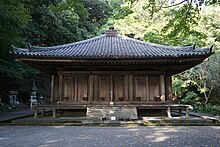Fuki-ji
The Fuki-ji ( Japanese 富貴 寺 ) is a temple of the Tendai direction of Buddhism in the city of Bungo-Takada in Ōita Prefecture .
history
The temple was created in the 12th century as a prayer temple ( 祈願 寺 , Kiganji ) for the chief priest of the Usa Hachiman-gū . He is one of the Rokugō manzan ( 六 郷 満 山 ), so one of the many temples (Manzan) on the six mountains ( Rokugō ) around and with the 720 m high mountain Futago ( 両 子 山 ), on the Kunisaki peninsula .
investment
Among the buildings in the temple, the Great Hall ( 大堂 , Ōdō) is the oldest wooden building in all of Kyūshū and is registered as a national treasure. The not very large hall is 3 ken , here around 7.7 m wide and 4 ken, here around 9.33 m deep. She is surrounded by a broad society. The roof, which is covered with tiles in the form of the rare Gyōki-buki, converges in a point, thus has an approximate pyramid shape. However, it does not appear to be the original roof.
The hall serves as a backdrop for regular open-air concerts.
Near the hall are five differently designed Buddhist tombs ( 傘 塔 婆 , Kasatōba ) made of stone from the middle of the 13th century. They are registered as an important cultural asset of the prefecture.
Treasures of the temple
The main cult figure is a seated Amida Nyorai, who is 85.7 cm high and is composed of pieces of yew wood . It dates from the end of the 12th century. It is kept in the so-called Jōchō style ( 定 朝 様 ). The figure was originally painted, but it has been lost.
In addition, a trinity consisting of an Aida Buddha and two protective companions is venerated in the hall. It is registered as an important cultural asset of the prefecture. The Buddha figure in the middle is 87.5 cm high, the Kannon standing on the left is 103 cm and the Kannon standing on the right is 102.5 cm high. The figures made of cedar wood are dated to the Heian period . Originally, this group was the most important.
Remarks
- ↑ In the Gyōki-buki ( 行 基 葺 き ) narrow roof tiles are inserted between the roof tiles.
literature
- Ōita-ken kotogakko kyoiku kenkyukai chiri rekishi-ka komin-ka bukai (Ed.): Fuki-ji . In: Ōita-ken no rekishi sampo . Yamakawa Shuppan, 2006. ISBN 978-4-634-24644-7 .
Web links
Coordinates: 33 ° 32 ′ 15.8 " N , 131 ° 31 ′ 43.5" E



